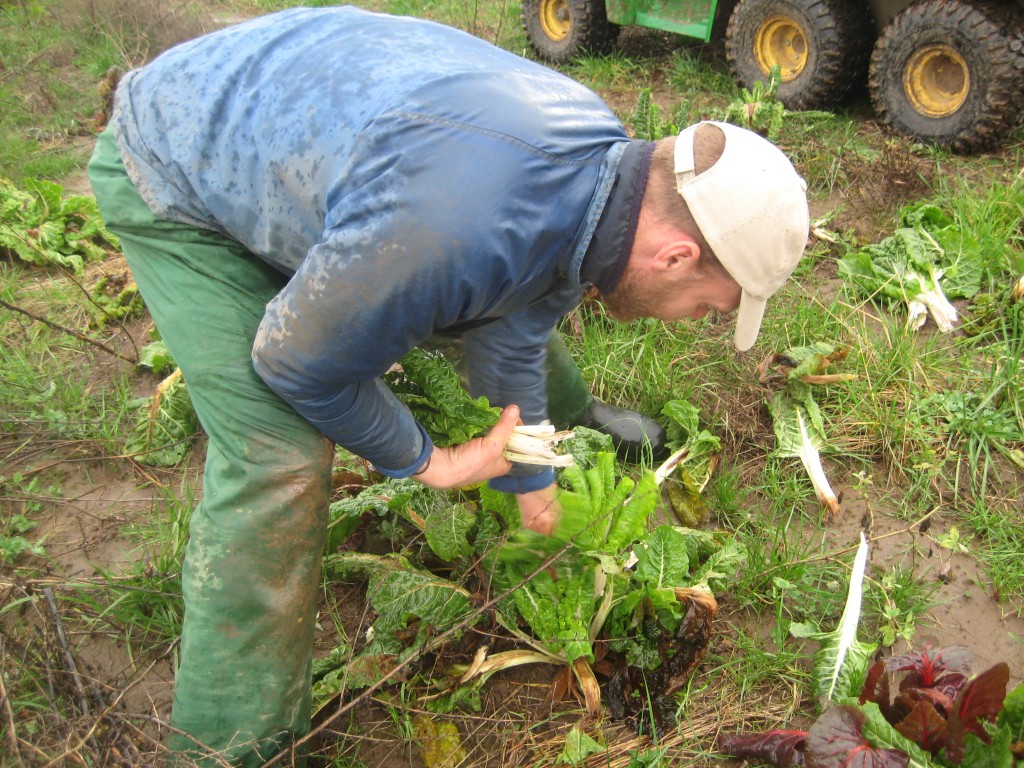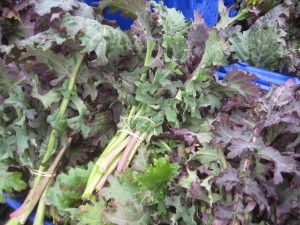
Quickly seeing and picking the beautiful full-grown chard leaves within a plant of winter-beaten and too-small leaves is an art. Winter harvests can be very fun and satisfying — especially if wearing the appropriate clothing.
Once again this year, I am reminded that one unique aspect of winter life on the farm is talking. Connecting and talking with other farmers in ways that we don’t really have time to do during the growing season (and neither do they!). I mentioned in last week’s newsletter sitting down to chat at length with the folks from LETumEAT. This afternoon, we hosted a group of farmers from all across the valley who have been participating in a “Winter Farming” workshop.
Casey gave the group a tour of our farm, in all its present winter glory (the return of rising flood waters included!). We always wonder at what others see when they look at our winter fields, because — well — it can be hard to make sense of what’s going on out here. Summer fields are relatively easy to “take in” — rows and rows of growing vegetables at various stages of maturity paint the perfect picture of a classic market garden. But in winter, we nurture and care for plants that grow much slower (cold + lack of sunlight). Because of that, we go into winter with quite a lot of our ground planted to hardy vegetables of some age. But some of those veggies will basically just hang out in our fields until late winter or spring. Tiny turnip plants will make quite unimpressive rows of scraggly greens until early February when they begin to lengthen and throw out their tasty buds and new leaves — that’s the gold for us, and we harvest it almost as soon as it arrives, knowing that those late winter and early spring crops come and go more swiftly than you might imagine after so many weeks and months of waiting.
In other rows, such as our chard and kale plants, we bring older more mature plants into winter, knowing full well that the leaves on the plants in November will probably never be harvested. Instead, the will become the shelter for the younger leaves that will weather all the storms and frosts of winter. Then, as those leaves grow, we will pick them (moving aside the now bedraggled leaves that have covered them).
Yes, the landscape of our farm looks profoundly different and quite a bit more mysterious right now. Even sweet roots like parsnips hide beneath the mud, leaving almost no signs of their presence above (their greens having been frost killed weeks ago).
So, we shared that scene with farmers today with a sense that what we see and value might not translate. That’s a perennial challenge with transferring information about the farm to others. So much of what happens out here takes quite a lot of patience and time to see and understand. Certainly one can appreciate the broad picture of the farm with a quick walk through, but one won’t notice the particular winter weeds that are growing at the base of the mustard greens or that some of the Red Russian kale plants have begun to divide and grow smaller leaves (an early sign that rapini is coming soon!).
I think that this phenomenon of patience and time in one place is perhaps the defining element of our experience on the farm — that experience of seeing everything come more and more into focus over time. How is it that we are still noticing new things in this place where we have lived and worked for ten years? And, yet, we do. New patterns become visible that help us understand prior seasons. We identify a songbird for the first time that has probably been visiting our yard for all ten years. The complexity of the place becomes more and more real, keeping us humble even as we grow in our understanding.
And, winter is definitely a time requiring extra patience and time to understand — trees bare of leaves stand stark, asking you to learn them again from their shape and their bark. Weeds become greener than certain vegetables in the fields, asking you to see abundance in new forms.
Casey once said something wise to a then newly hired employee. Casey himself doesn’t remember saying it, but the employee did and related it to us years later. He said: “I’m not a good teacher, but the farm is. Pay attention, and you’ll learn.” Yes, and yes, and yes. The farm has been our teacher for ten years now, and although I miss the days of having human mentors to guide us, the farm has taught us over and over and over again about this place, its life, and how to do our work.
Which is why, although we enjoy talking with other farmers (and think it is a critical piece of this whole farming-in-community-experience), we now take those experiences with a grain of salt. We want to share our experience, yes. We want to hear other people’s experiences, yes! Those connections allow us to grow and understand our experiences in totally new ways that can be transformative in profound ways. In fact, we look forward to having more such conversations as winter continues and we continue with the winter talking work. But those conversations are certainly most fruitful with the foundation of the first-hand work and immersion. For us, a little bit of talk in the winter (plus a few good books and magazine articles) can be enough to propel us into our next season with new ideas and energy for how to work through the perennial challenges of this beautiful work!
And, while I’m speaking of conversations and connecting, I have to mention what a joy it was to reconnect with all of you last week at pick-up. We love the farm; we love our work; we love sharing it with you. We also love all the conversations we get to have with you all about other parts of life. It’s a special treat to simultaneously get to share our harvest and also step out of our normal farm-focused life to check in with our wider community about all the projects you are working on. We love hearing about the lessons you are learning, your challenges and joys. Those hours at the pick-up are a highlight of our week, and we look forward to doing it again tomorrow!
Enjoy this week’s vegetables!
Your farmers, Katie & Casey Kulla
~ ~ ~
Meet this week’s vegetables:
- Goldrush apples — These apples won our apple variety trial tasting that we hosted at our fall open house. They are great for eating, with a crisp, strong and tangy sweet flavor. They are also wonderful for baking or cooking. They are our apple of choice if we want to make a pie or tart.
- Purple-top and scarlet turnips — Turnips that are red outside! These serve two purposes in our winter fields. We can pick them now for turnips to eat, or wait and enjoy the earliest rapini of the year from these plants. We try to do a little of both.
- Chard
- Mustard greens
- Kale
- Butternut squash
- Marina di Chioggia and Crown Pumpkin winter squash
- Carrots
- Parsnips
- Potatoes — I blew Rusty’s mind this week by roasting some really great potatoes. I know, such a simple food! But I feel like this winter I’ve truly mastered the art of roasting (perhaps it helps that I’m less interrupted in my cooking than in recent years of babies and toddlers crying regularly!). For the potatoes, I peeled them, then cut them into 1/2 inch chunks and roasted them in a pan with plenty of butter at 375°. I stirred frequently so that all sides of the potato got coated with butter and got crispy brown on the outside, just as the insides were getting deliciously soft. I roasted parsnips at the same time, using the same method (but with smaller pieces, since parsnips are denser than potatoes). We enjoyed it all, but Rusty has requested the potatoes for every meal since.
- Leeks
~ ~ ~
And this week’s extra goodies from the farm:
Eggs— NOT QUITE YET! More and more eggs get laid every day as our hens mature!- Stewing hens — We still have stewing hens for sale — get them while they last! $3.50/lb. I’ve been enjoying making very simple soups while the rest of our meal is cooking. I fill a small sauce pot with finely chopped, peeled root veggies and cover with chicken stock and simmer until the rest of the meal is ready. Then I add some butter (because fat is yummy) and salt and puree with my hand blender. This soup can be made with any kind of root veggies and makes a great side to winter meals. Soup is so warming, and starting with the base of a delicious chicken stock makes it super easy to accomplish a quick soup!
- Pork — Roasts and ground pork are $8/lb; pork chops and hams are $12/lb. We find that pork goes especially well with all kinds of greens. We’ll often cook a roast in our crock pot (we prefer to do this without adding any liquid so that the meat caramelizes and retains all its flavor). Then we chop the cooked meat and throw it into the pan as we finish cooking greens. With a little tasty goat cheese and sauerkraut over the top (and perhaps a cup of soup on the side), this makes a warming winter meal all on its own!
- Lamb — Roasts and ground lamb are $8/lb; chops are $12/lb.
Beef— We are still temporarily out of beef, but I wanted to give the update that we are sending an animal to the butcher next week! It will still be a couple of weeks for the beef to hang and be processed, but more ground beef (and perhaps some cuts too!) will be on their way soon!



